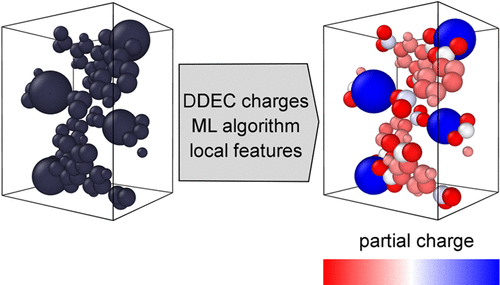当前位置:
X-MOL 学术
›
Chem. Mater.
›
论文详情
Our official English website, www.x-mol.net, welcomes your feedback! (Note: you will need to create a separate account there.)
Transferable and Extensible Machine Learning-Derived Atomic Charges for Modeling Hybrid Nanoporous Materials
Chemistry of Materials ( IF 8.6 ) Pub Date : 2020-08-25 , DOI: 10.1021/acs.chemmater.0c02468 Vadim V. Korolev 1, 2 , Artem Mitrofanov 1, 2 , Ekaterina I. Marchenko 3, 4 , Nickolay N. Eremin 4 , Valery Tkachenko 1 , Stepan N. Kalmykov 2
Chemistry of Materials ( IF 8.6 ) Pub Date : 2020-08-25 , DOI: 10.1021/acs.chemmater.0c02468 Vadim V. Korolev 1, 2 , Artem Mitrofanov 1, 2 , Ekaterina I. Marchenko 3, 4 , Nickolay N. Eremin 4 , Valery Tkachenko 1 , Stepan N. Kalmykov 2
Affiliation

|
Nanoporous materials have attracted significant interest as an emerging platform for adsorption-related applications. The high-throughput computational screening became a standard technique to access the performance of thousands of candidates, but its accuracy is highly dependent on a partial charge assignment method. In this study, we propose a machine learning model that can reconcile the benefits of two main approaches: the high accuracy of density-derived electrostatic and chemical charge (DDEC) method and the scalability of charge equilibration (Qeq) method. The mean absolute deviation of predicted partial charges from the original DDEC counterparts achieves an excellent level of 0.01 e. The model, initially designed for metal–organic frameworks (MOFs), is also capable of assigning charges to another class of nanoporous materials, covalent organic frameworks, with acceptable accuracy. Adsorption properties of carbon dioxide, calculated by means of machine learning-derived charges, are consistent with the reference data obtained with DDEC charges. We also provide the first virtually complete set of partial charges for the publicly available subset of the Computation-Ready, Experimental (CoRE) MOF 2019 database.
中文翻译:

可转移和可扩展的机器学习衍生的原子电荷,用于建模纳米多孔材料。
纳米多孔材料作为吸附相关应用的新兴平台已引起人们极大的兴趣。高通量计算筛选成为访问数千名考生表现的一种标准技术,但其准确性高度依赖于部分电荷分配方法。在这项研究中,我们提出了一种机器学习模型,该模型可以调和两种主要方法的好处:密度衍生的静电和化学电荷(DDEC)方法的高精度和电荷平衡(Qeq)方法的可扩展性。与原始DDEC对应物相比,预测的部分电荷的平均绝对偏差达到0.01 e的出色水平。该模型最初是为金属有机框架(MOF)设计的,它还能够将电荷分配给另一类纳米多孔材料,共价有机框架,且具有可接受的准确性。通过机器学习衍生的电荷计算出的二氧化碳吸附特性与使用DDEC电荷获得的参考数据一致。我们还为计算就绪,实验(CoRE)MOF 2019数据库的公共可用子集提供了第一套几乎完整的部分费用。
更新日期:2020-09-22
中文翻译:

可转移和可扩展的机器学习衍生的原子电荷,用于建模纳米多孔材料。
纳米多孔材料作为吸附相关应用的新兴平台已引起人们极大的兴趣。高通量计算筛选成为访问数千名考生表现的一种标准技术,但其准确性高度依赖于部分电荷分配方法。在这项研究中,我们提出了一种机器学习模型,该模型可以调和两种主要方法的好处:密度衍生的静电和化学电荷(DDEC)方法的高精度和电荷平衡(Qeq)方法的可扩展性。与原始DDEC对应物相比,预测的部分电荷的平均绝对偏差达到0.01 e的出色水平。该模型最初是为金属有机框架(MOF)设计的,它还能够将电荷分配给另一类纳米多孔材料,共价有机框架,且具有可接受的准确性。通过机器学习衍生的电荷计算出的二氧化碳吸附特性与使用DDEC电荷获得的参考数据一致。我们还为计算就绪,实验(CoRE)MOF 2019数据库的公共可用子集提供了第一套几乎完整的部分费用。



























 京公网安备 11010802027423号
京公网安备 11010802027423号